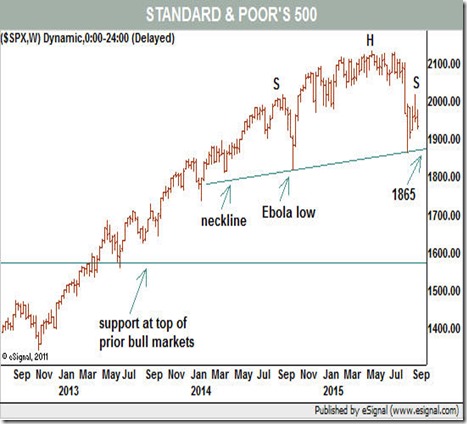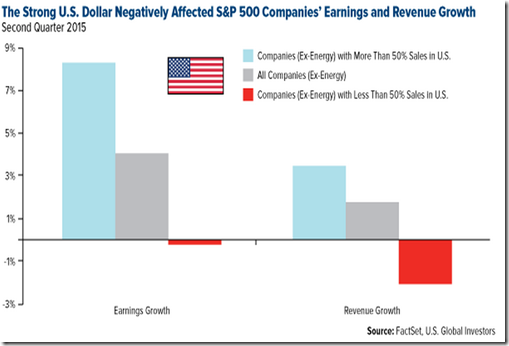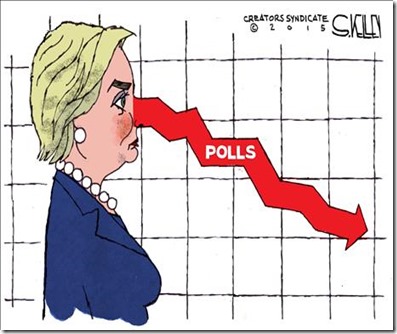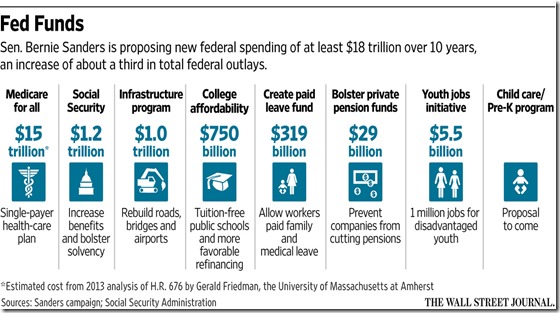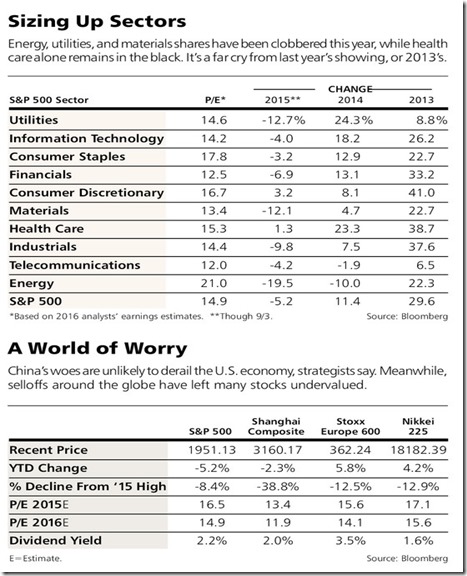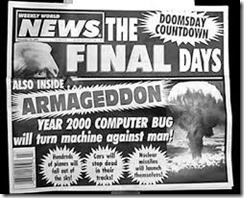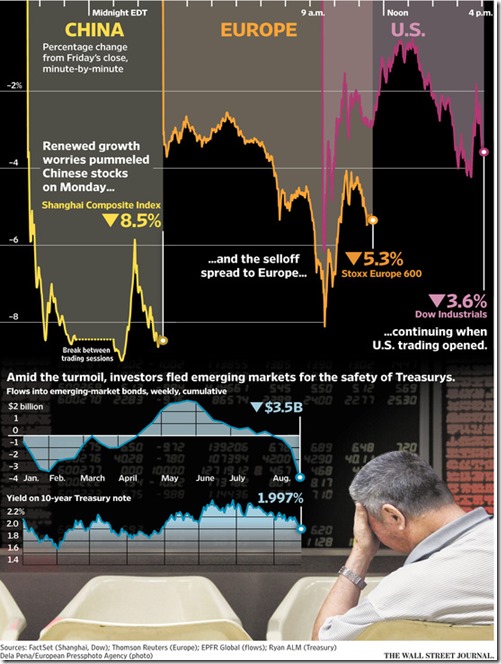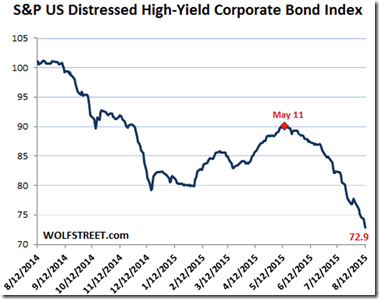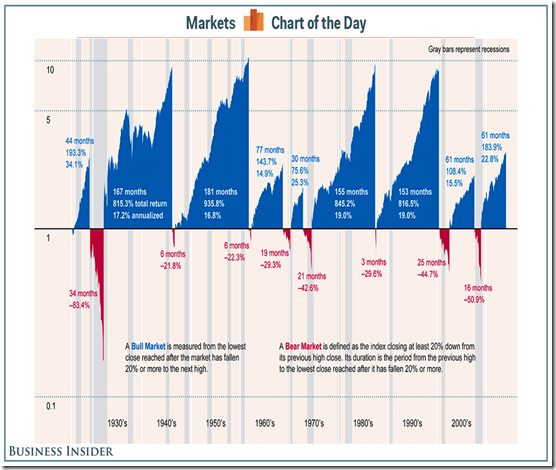TECHNICAL CHARTS FLASH DANGER FOR BULLS
Michael Kahn, Barrons ‘Getting Technical’ writer, reported September 23rd, the Head and Shoulders pattern is forming. It could portend to the markets falling further. However, head and shoulders patterns do not demand that a decline continue unless the neckline is penetrated to the downside. If buyers emerge, writes Kahn, than the decline will be halted. The good news is that failed bearish technical patterns often result in new bullish conditions. In other words, that could be it for the bears. – Barrons.com 9/23/2015 Source Getting Technical.
 The U.S stock market is in the ‘middle innings’ of a secular bull run that began in March, 2009.- Art Hogan, chief marketing strategist at Wunderlich Securities. WSJ- 2-8-2015. ‘
The U.S stock market is in the ‘middle innings’ of a secular bull run that began in March, 2009.- Art Hogan, chief marketing strategist at Wunderlich Securities. WSJ- 2-8-2015. ‘
 WHAT DOES THE FEDERAL RESERVE KNOW THAT INVESTORS DON’T. Friday 9/18 the Dow fell almost 300 points, the single worst day since September 1st and the day after the Federal Reserve voted ‘Nyet’ on an interest rate hike citing global concerns. While there were some (including Jim Cramer) who predicted that even a small(ish) rate hike would tank markets, no one predicted a drubbing if the Federal Reserve did nothing. In last weekend’s ‘Stocks to Watch’ in Barron’s.com, Ben Levisohn reported that Brian Belski of BMO argued the Federal Reserve needed to act and not react. Belski also said that the Fed was sending the wrong message and is focused too much on what was instead of what is. Belski goes on:
WHAT DOES THE FEDERAL RESERVE KNOW THAT INVESTORS DON’T. Friday 9/18 the Dow fell almost 300 points, the single worst day since September 1st and the day after the Federal Reserve voted ‘Nyet’ on an interest rate hike citing global concerns. While there were some (including Jim Cramer) who predicted that even a small(ish) rate hike would tank markets, no one predicted a drubbing if the Federal Reserve did nothing. In last weekend’s ‘Stocks to Watch’ in Barron’s.com, Ben Levisohn reported that Brian Belski of BMO argued the Federal Reserve needed to act and not react. Belski also said that the Fed was sending the wrong message and is focused too much on what was instead of what is. Belski goes on:
- China volatility not a surprise.
- U.S. stock market correct was inevitable, expected and healthy.
- Inflation is muted, and will remain so.
- The Fed’s conservative tone will not put the brakes on ‘our’ 15-20 year secular bull thesis. SOURCE BARRONS.COM 9/19/2015
Friday was also ‘Options Expiration Day’, and historically there is added volatility as traders/investors close positions.
Explaining the (mis) behavior of Markets…
Fractal Mathematics is an application to better model the financial markets. You may be hearing more of this as time goes on. Fractal is a pattern or shape whose parts echo the whole. A form of geometric repetition. Benoit B. Mandelbrot was the first person to develop a computer program to print graphics. He used the computer graphics to create and display fractal geometric images. Mandelbrot’s basic premise is that things that are considered chaotic actually have an order. By using fractal geometry he discovered that smaller patterns of the whole are inside whatever pattern he was examining. While Modern Portfolio Theory believes that all markets are unpredictable and chaotic Mandelbrot’s findings are that the market moves in patterns. There are periods of extreme risk, and fractal mathematics is one way to understand and use it to the benefit of investors. Here are a few of his ideas that you may find interesting:
- Trouble runs in streaks. Market turbulence tends to cluster.
- Markets have personality
- Markets mislead. People want to see patterns in the world. We see patterns where there are none.
- Markets in all places and ages work alike.
- Price changes are not independent of each other. Today does influence tomorrow. SOURCE 9/17/2015 PROACTIVE ADVISOR MAGAZINE.COM
Don’t Let Stock Market Extremists Scare You. You cannot turn on the t.v. or radio without having someone tell you to sell your investments and run to gold, oil, real estate or mattresses. There is an agenda out there to scare investors into selling what they own and to have them come back and buy the same thing at a higher price, or something the ‘scaree’ is selling. The fact is that 72% of the time since 1947 the S&P 500’s price was up. Add in dividends reinvested and it jumped to 80%. Another fact is that in most years you’re likely to see gains by December 31st. Over rolling 10-year periods the median average annual gain was almost 12%. You can’t get that by going in and out of the market. The only thing you need to do is stay in and ride out the bad times along with the good. Source Money Magazine August 21, 2015 Sam Stovall, S&P Capital IQ equity strategist.
You cannot turn on the t.v. or radio without having someone tell you to sell your investments and run to gold, oil, real estate or mattresses. There is an agenda out there to scare investors into selling what they own and to have them come back and buy the same thing at a higher price, or something the ‘scaree’ is selling. The fact is that 72% of the time since 1947 the S&P 500’s price was up. Add in dividends reinvested and it jumped to 80%. Another fact is that in most years you’re likely to see gains by December 31st. Over rolling 10-year periods the median average annual gain was almost 12%. You can’t get that by going in and out of the market. The only thing you need to do is stay in and ride out the bad times along with the good. Source Money Magazine August 21, 2015 Sam Stovall, S&P Capital IQ equity strategist.
 The next time someone tells you to run out of the market or do some other foolishness recite the above and let them do their homework to try and prove you wrong.
The next time someone tells you to run out of the market or do some other foolishness recite the above and let them do their homework to try and prove you wrong.
Markets Hung On to Gains Monday 9/21 With All Indices Up.
Contradicting Some Experts Robert C. Doll, CFA Senior Portfolio Manager Nuveen Asset Management reported in his 9/21 Weekly Investment Commentary: The Fed’s decision to keep rates on hold may have been a mistake and could act as a headwind for equities.
Deteriorating credit conditions could act as a headwind for equities. We think credit spreads have been widening over the past three months for three reasons:
- Weakening credit fundamentals
- Deflationary pressures from emerging markets
- Concerns over Fed tightening
If credit markets don’t improve in the coming months, equity rallies may be difficult to maintain.-Robert C. Doll 9/21
 A Tweet, A Plan For A Plan & A Fall. ‘Price gouging in the specialty drug market is outrageous,’ tweeted Hillary in response to the news that a certain drug maker upped the price of a drug more than 50-fold. Biotech stocks crashed and the iShares biotech ETF fell 4.5%. The presidential hopeful said she would propose a plan to address high drug prices. WSJ 9/21/2015
A Tweet, A Plan For A Plan & A Fall. ‘Price gouging in the specialty drug market is outrageous,’ tweeted Hillary in response to the news that a certain drug maker upped the price of a drug more than 50-fold. Biotech stocks crashed and the iShares biotech ETF fell 4.5%. The presidential hopeful said she would propose a plan to address high drug prices. WSJ 9/21/2015
 Markets are so delicate that any news, rumor or ‘tweet’ causes panic. It wasn’t that long ago that markets shrugged off ‘bad’ news and kept chugging forward.
Markets are so delicate that any news, rumor or ‘tweet’ causes panic. It wasn’t that long ago that markets shrugged off ‘bad’ news and kept chugging forward.
Tuesday Had Another Rough Session. Global Growth Worries Fueled A Commodity Rout. Steel, mining and transportation stocks lagged. Oil fell 1.8%. The 10-year fell to 2.13%. IBD 9-23-2015
 The Hillary Drug Cap Plan to Hold Out-of-Pocket Prescription Costs to $250 a Month would raise premiums and modestly reduce the ranks of the insured, partly to push small businesses to drop coverage. This, according to Jed Graham at IBD, is exactly what drug companies want. Biotech’s continued their slide Tuesday although experts appearing on CNBC Tuesday reported that the sector has endured sell-offs over the past five years and recovered nicely each time. CNBC 9/22/2015
The Hillary Drug Cap Plan to Hold Out-of-Pocket Prescription Costs to $250 a Month would raise premiums and modestly reduce the ranks of the insured, partly to push small businesses to drop coverage. This, according to Jed Graham at IBD, is exactly what drug companies want. Biotech’s continued their slide Tuesday although experts appearing on CNBC Tuesday reported that the sector has endured sell-offs over the past five years and recovered nicely each time. CNBC 9/22/2015
Thursday’s Markets Were Down Triple Digit But Closed Way Off Their Lows. Fed Chief Janet Yellen Spoke After the Close & Assured That The Fed Rate Hike Was Still On for 2015. sources cnbc & WSJ. 9-25-2015
 Our Blundering Fed, was the title of a missive sent last Tuesday by Mark J Grant, managing director for taxable fixed income at Southwest Securities. Feedback from Grant’s article, who consist of thousands of major institutional investors in the U.S. and abroad, never was so strongly in agreement. The mixed message from various Fed speakers were adding to the downward pressures in the market, they insisted. Since the U.S. central bank surprised many by opting not to initiate the first increase in nine years, no less than four Fed district presidents have spoken out about the decision. Rather than speaking out in a single voice, they’ve been split between those supporting the decision to delay rate hikes and those wanting an immediate move. Source Barrons.com 9/23/2015 Up and Down Wall Street, Randall W. Forsyth.
Our Blundering Fed, was the title of a missive sent last Tuesday by Mark J Grant, managing director for taxable fixed income at Southwest Securities. Feedback from Grant’s article, who consist of thousands of major institutional investors in the U.S. and abroad, never was so strongly in agreement. The mixed message from various Fed speakers were adding to the downward pressures in the market, they insisted. Since the U.S. central bank surprised many by opting not to initiate the first increase in nine years, no less than four Fed district presidents have spoken out about the decision. Rather than speaking out in a single voice, they’ve been split between those supporting the decision to delay rate hikes and those wanting an immediate move. Source Barrons.com 9/23/2015 Up and Down Wall Street, Randall W. Forsyth.
Questions call Paul @ 586 295 0430 or write him at pstanley@westminsterfinancial.com. Share this blog with someone who cares about their money.
SECURITIES OFFERED THROUGH WESTMINSTER FINANCIAL SECURITIES, INC. MEMBER FINRA/SIPC.
